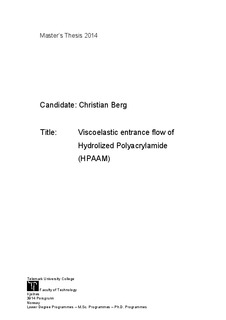| dc.description.abstract | The use of polymers in polymer/water flooding enhanced oil recovery (EOR) is a technique used since just after World War 2, and with several full scale fields in operation. Increasing oil prices and more challenging reservoirs make polymer flooding even more interesting as a EOR method in modern times. One of the most common EOR polymers, hydrolyzed polyacrylamide (HPAAM) is a synthetically produced water soluble high molecular weight polymer. HPAAM acts shear thinning in bulk rheological measurements, but when flooded through porous media a rapid increase in resistance to flow (increasing apparent viscosity) is observed with flow rate, starting at a critical flow rate. This effect is poorly understood, but thought to be due to viscoelasticity, and the polymer molecules uncoiling in the "stretch" flow in pore entrances. After a local maximum, the apparent viscosity decrease, thought to be due to mechanical degradation mechanisms. The flow of HPAAM in short and long capillary tubes has been studied experimentally, and found to exhibit the same behaviour as in porous media. A local maximum in apparent viscosity (caused by an inlet effect) and degradation after this local maximum was also observed. A Oldroyd-B viscoelastic model was implemented in ANSYS Fluent to study the inlet pressure drop observed experimentally, but although the model shows promise for predicting some viscoelastic phenomena it fails to predict the high inlet pressure losses. CFD simulations with Newtonian fluids were used to study the proportionality between max stretch rate and wall shear rate for the experimental geometry, often considered proportional in literature. It was found that for the experimental geometry the proportionality seems Reynolds number dependent, approaching a constant value. The effect of having a highly viscoelastic fluid in the inlet, and its influence on the flow is uncertain, but literature shows that viscoelasticity can have a high impact on entrance flow. | |
